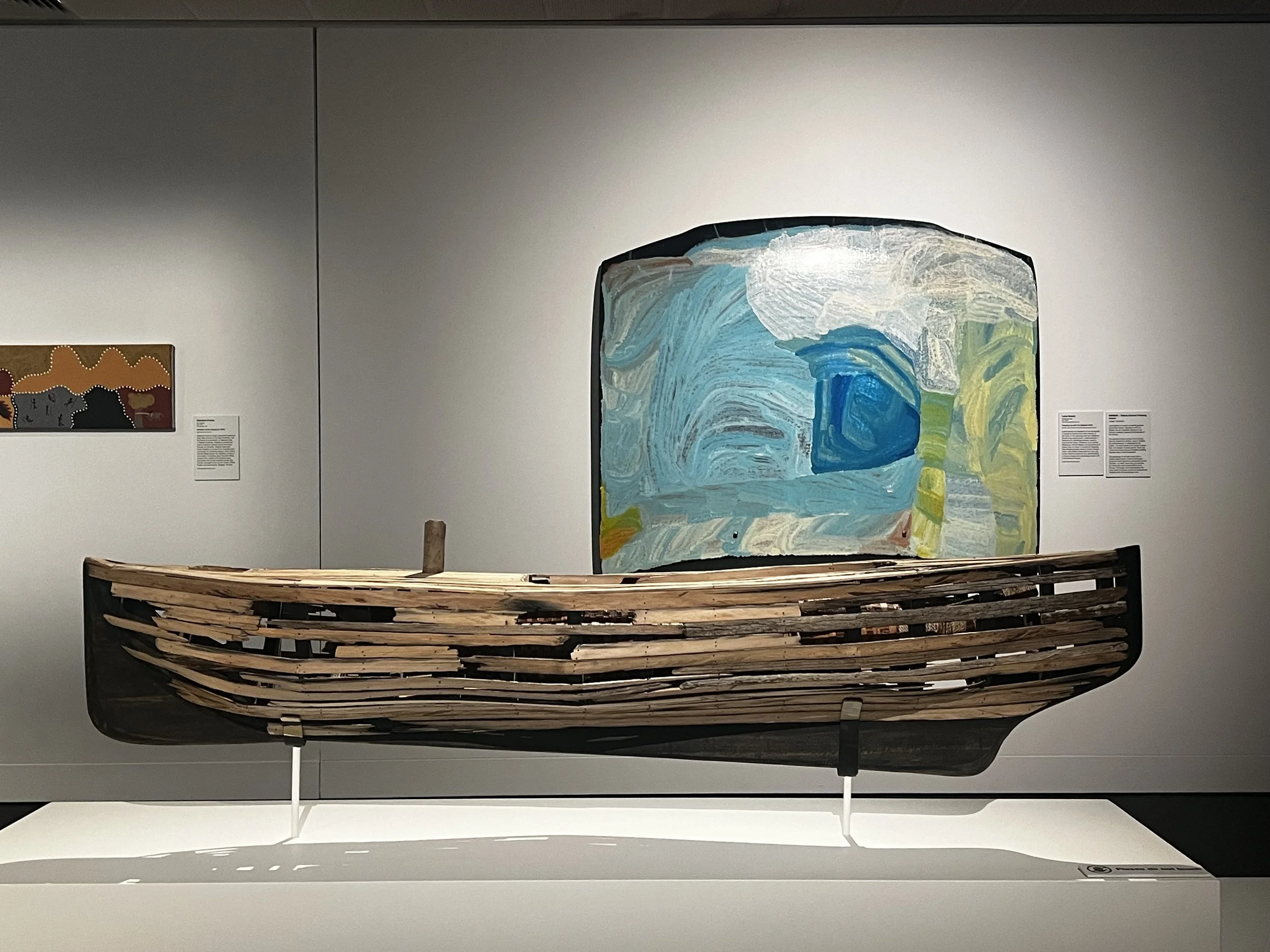Sometimes Wet, Sometimes Dry
Black Bastards are coming // a re-imagining by Gordon Syron, 2013.
Consider this – a seamless state of being between land, sea, sky. Fluidity, no division. Oneness, nothing for sale, only a continuous state of being, a feeling of connection to the surrounding world. Sometimes land country, sometimes sky country, sometimes sea country.
Somewhere along the way, we have disregarded Indigenous connection to the environment as a whole. Currently showing in Darwin, the Telstra 2024 National Aboriginal and Torres Strait Islander Art Awards has two pieces of work, created to explore the concept of sea country and an ability to move from one space - land – to another, sea.
Tunapri Milaythina Muka, To know Sea Country through making by Dean Greeno
“This work provides a view of my cultural heritage through time, drawing on my personal history, family and community connections as a Truwulway Paka man of Luturwit. With maritime/Sea Country connections as the central concern. It’s presented as multi-layered, three-dimensional object which speaks to identity, cultural continuity and adaptive generational activity prior to and following disruption.”
Lipa’lipa ga dhomola Dugout canoe and woven pandanus sail by Helen Ganalmirriwuy Garrawurra
“This is Lipa’lipa a wooden dugout canoe. I learnt this from my father who was a hunter and a sailor. He leant from my grand-father who learnt from Mangatharra people (Makassan traders)”
And these boats communicate so much – an ability to travel, to link, they illustrate input from other cultures, other practices, a travelling knowledge of boat building from one place to another. We know this to be true – we understand the concept of exchange and how it involved the trade of cloth, tobacco, metal axes and knives, rice, and gin. In Arnhem Land the Yolngu traded turtle-shell, pearls and cypress pine, and some were employed as Trepangers, working as hunters and in process plants along the coast for hundreds of years. This all took place prior to colonial arrival in what we now know as Botany Bay and Sydney Harbour where waterways were contested and met with considerable early resistance.
While the colonists were quick to note how important canoes were to the Sydney people for use in fishing and travelling around the harbour, they also began to notice their utility in swift raids. Although nawi were often described as flimsy craft, several colonists noted how quickly the canoes could move through the water. Nawi were extremely versatile – swift and silent and easily landed anywhere. They were well suited to lightning raids and hasty retreats in the increasing guerilla warfare campaign that was hemming the colonists inside their encampment.
The importance of waterways in contests over resources has been recognised as a major reason for conflict between Europeans and First Nations people. But there has been little focus on how watercraft were used in warfare. Curator Dr Stephen Gapps has researched the subject, and also introduces new historical information from a recent museum acquisition that locates the site of the first confirmed deaths of Europeans at the hands of Aboriginal warriors.
“This relationship includes knowledge and use of lands that now lie beneath the ocean all around the coast, and between mainland Australia and Tasmania. Aboriginal people’s relationship with offshore waters was based on travel to islands in bark rafts and canoes, and the use and management of coastal species (eg migratory eels and muttonbirds) that are part of ocean ecosystems far distant from the coast.”
Indigenous people still relate to land that was inundated by sea during the last ice age and regard it as their own. Indigenous information passed down from generation to generation and archaeological records show that Aboriginal people occupied, used and managed coastal land and sea environments within the Region for many thousands of years before the current sea level stabilised about 5000 years ago.
"The sea was always there for us, even when the land had been carved up and sold off." Delia Lowe, Jerrinja Wandi Wandian woman from the south coast of New South Wales (Lowe and Davies 2001)
The allocation of coastal and sea rights to non-Indigenous people has changed the connections to place by contemporary Indigenous people. Indigenous people make no distinction between land and sea. They see themselves as having responsibilities and rights across the land and sea boundaries that have been put in place over the last 250 years.
Connected, land and sea, together they form people’s "Country" – a country of significant cultural sites and "Dreaming Tracks" of the creation ancestors. As a result, coastal environments are an integrated cultural landscape/seascape that is conceptually very different from the broader Australian view of land and sea.
So next time you’re on deck, look around and for a moment consider the concepts of being in one state – sometimes wet, sometimes dry – neither on land or on sea, you are simply on country.
——
Signals Quarterly - Edition 123 - Australian National Maritime Museum
TOP IMAGE
BLACK BASTARDS ARE COMING © Gordon Syron, 2013. This work re-imagines European contact from an Indigenous perspective. The artist reverses the roles of first contact by depicting black soldiers in military red coats, approaching shore and firing guns at the white people standing in the shallows.



